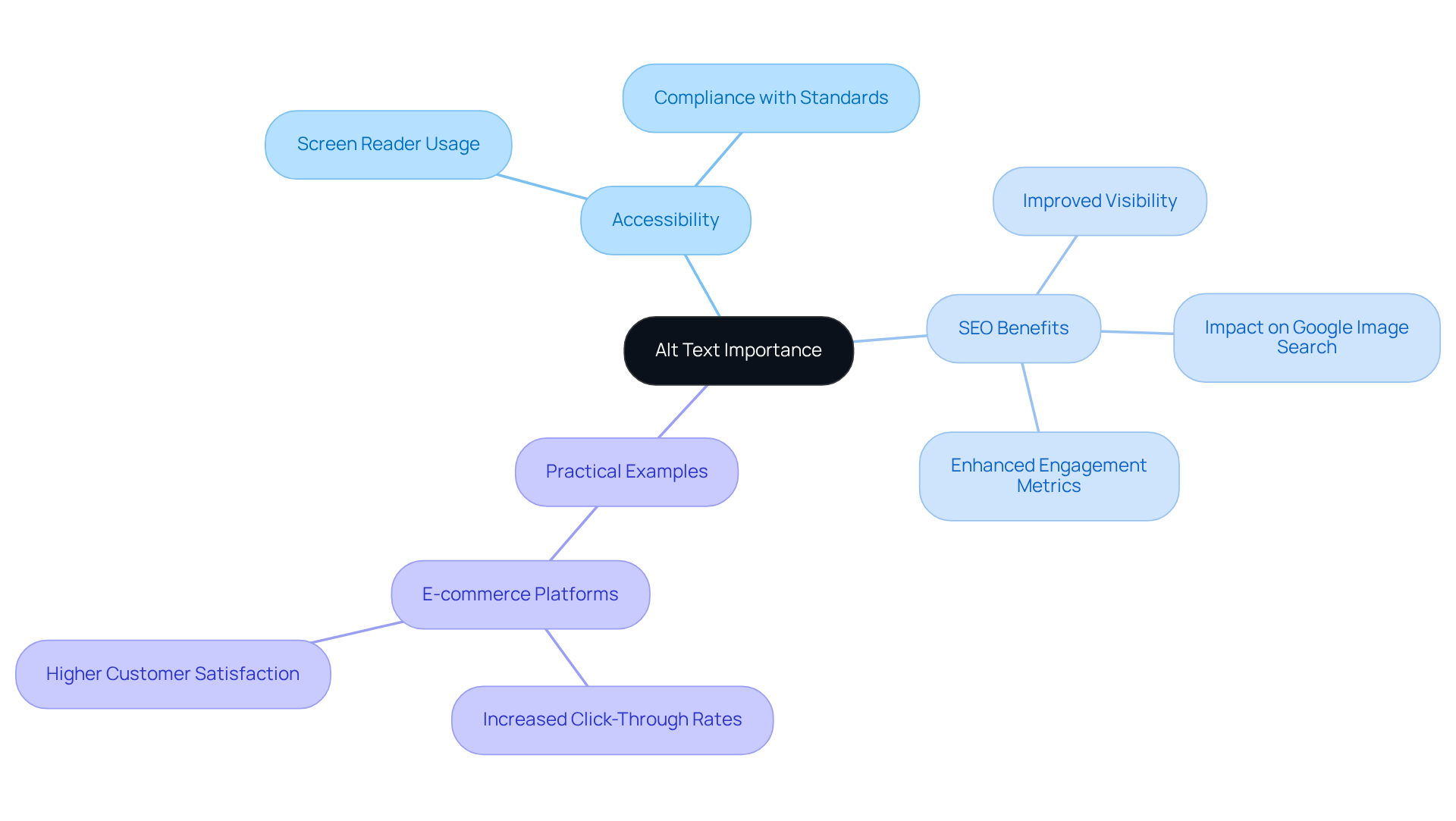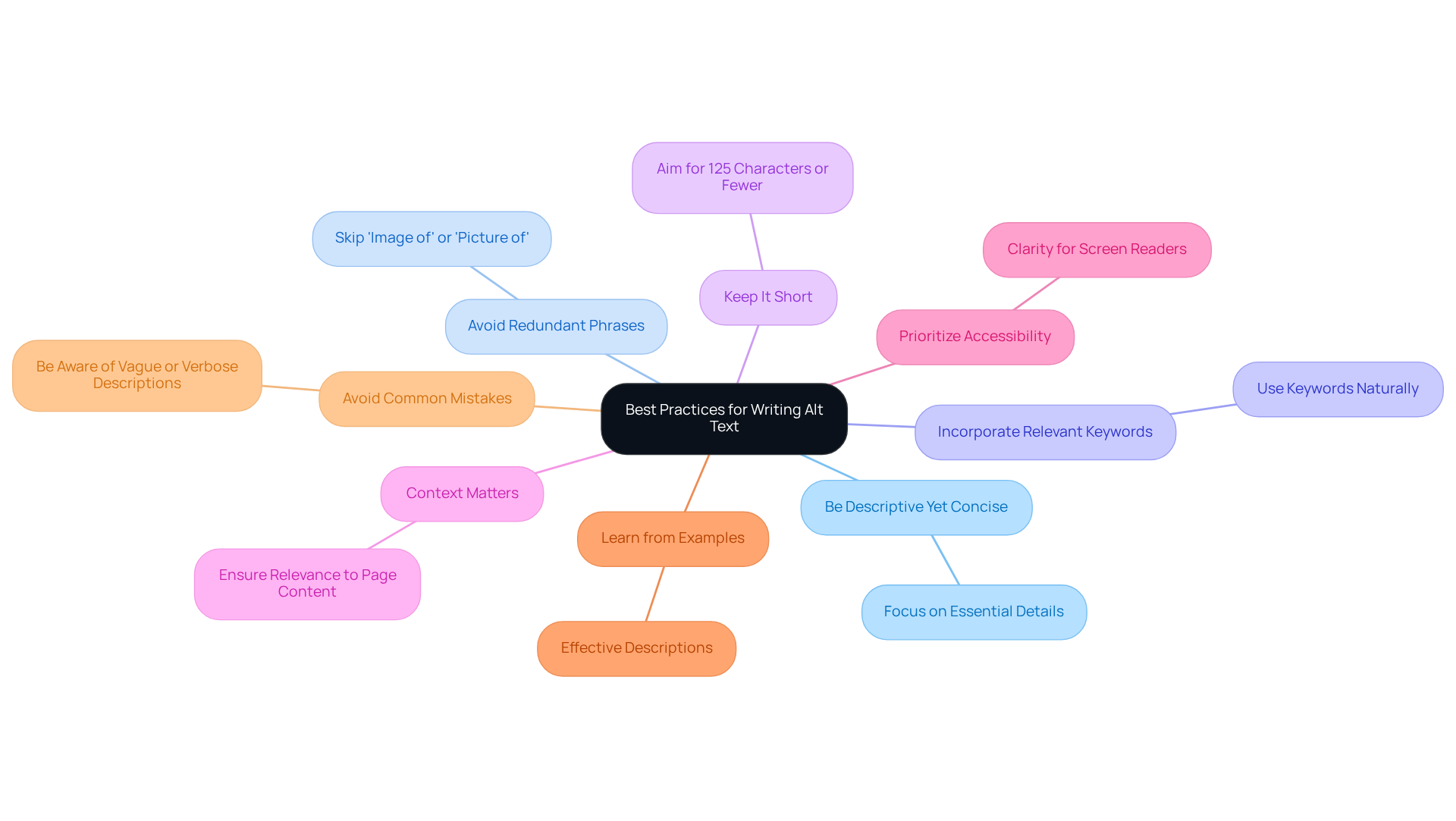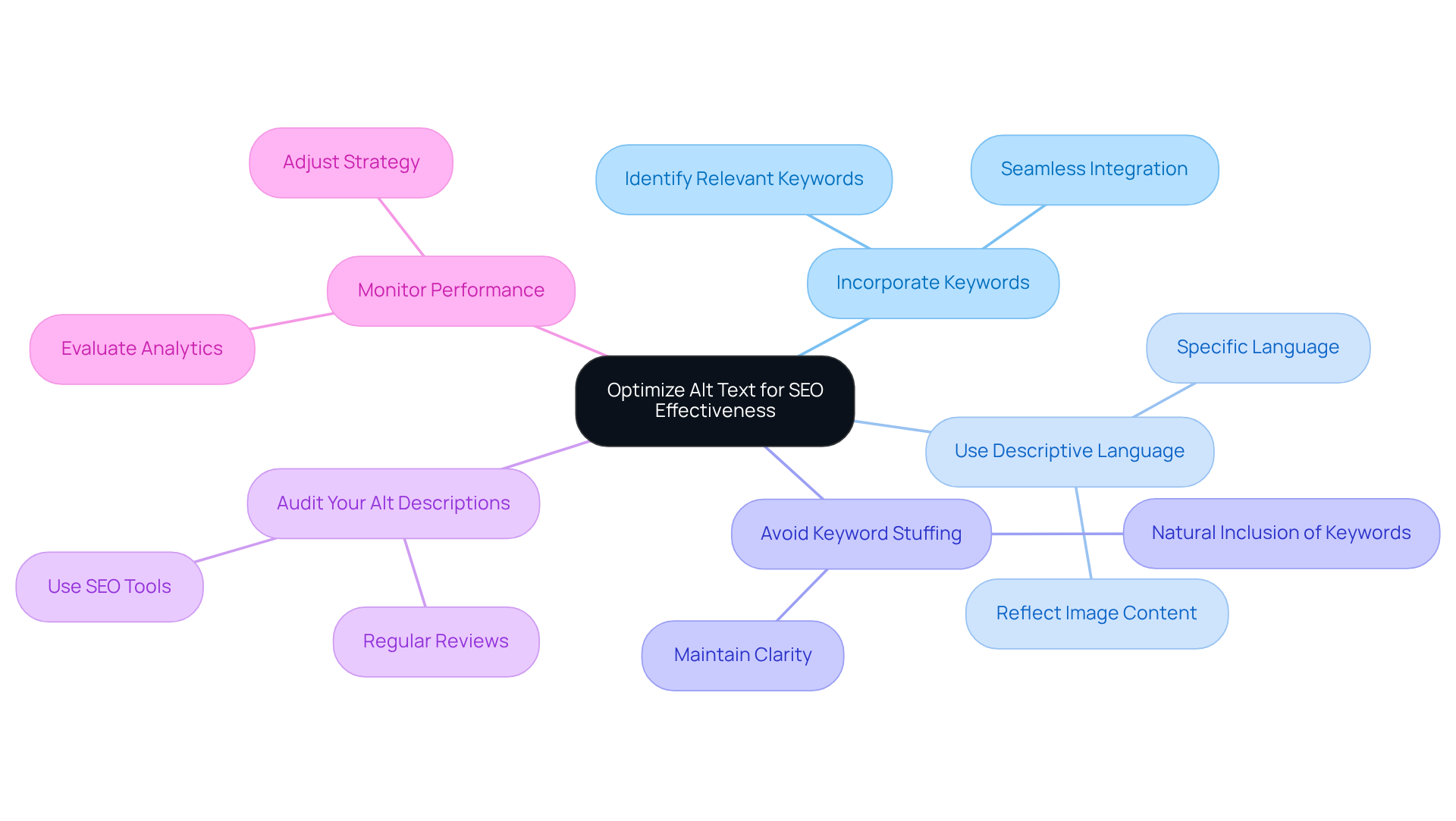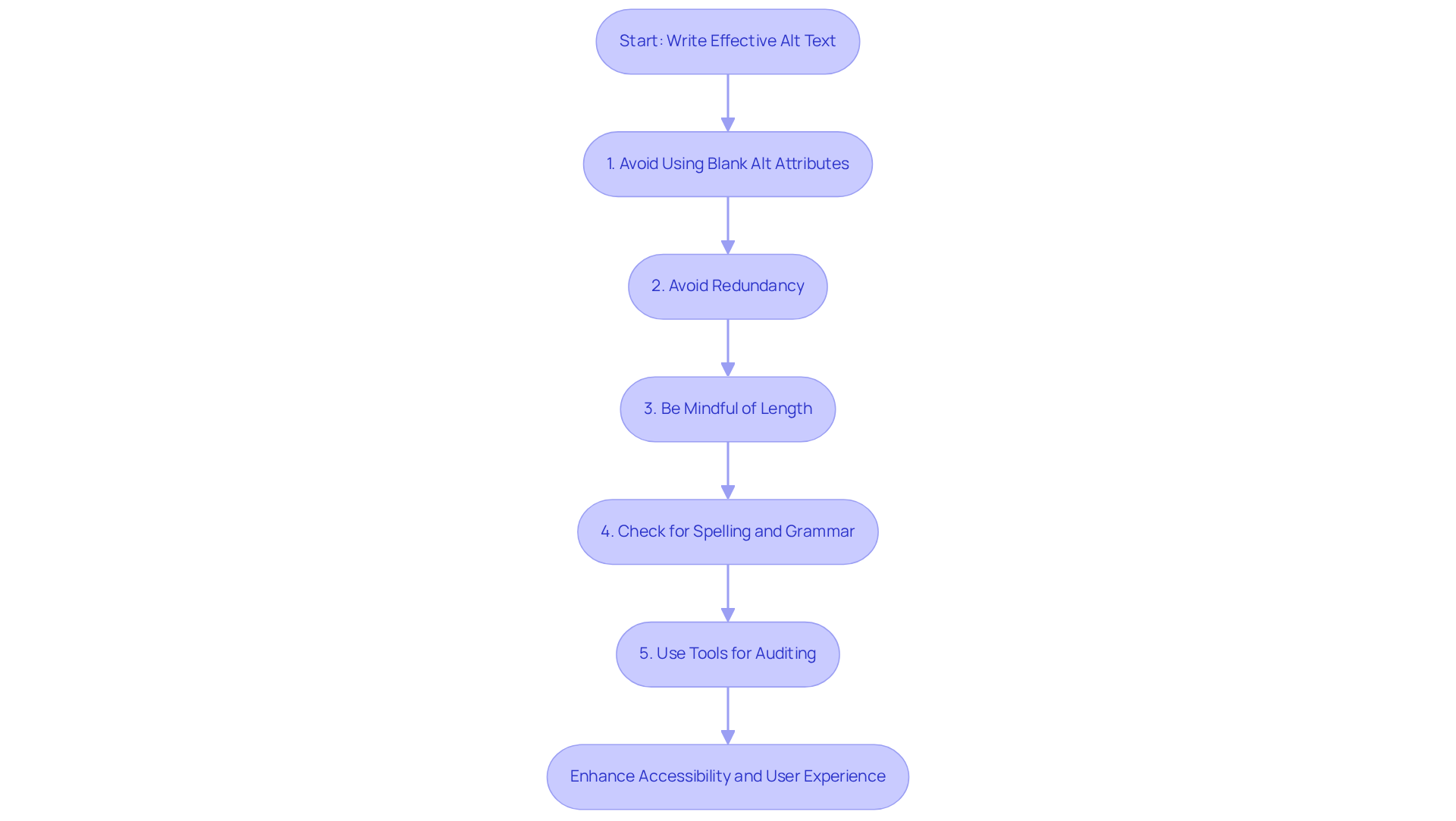Overview
In today's digital landscape, many tech startup founders face the challenge of ensuring their content is accessible to all users while also optimizing for search engines. This dual focus can feel overwhelming, especially when considering the implications of neglecting accessibility. Without proper alt tags, not only do we risk alienating users with visual impairments, but we also miss out on valuable search engine visibility.
However, there is a nurturing solution. Implementing effective alt tags is a straightforward yet impactful step towards enhancing user experience and boosting content visibility. Start by being descriptive yet concise in your alt text; think of it as a way to convey the essence of your images to those who cannot see them. Incorporating relevant keywords is also crucial, as it helps search engines understand your content better, ultimately leading to improved rankings.
It's easy to fall into common pitfalls, such as being overly vague or neglecting to include alt text altogether. By avoiding these mistakes, you create a more inclusive environment that reflects your commitment to accessibility. Remember, every step you take not only benefits your SEO strategy but also fosters a sense of community and support for all users. Together, we can make the web a more accessible place for everyone.
Introduction
In today's digital landscape, where visuals dominate, the effective use of alt text is not merely a best practice; it has become a necessity for ensuring accessibility and optimizing search engines. As search engines evolve, the significance of crafting descriptive and relevant alt tags has reached new heights. These tags act as a vital link between visual content and user engagement, yet many content creators find themselves grappling with how to implement alt text effectively. This struggle raises an important question: how can we master alt tags to enhance our SEO strategies while fostering inclusivity?
We understand that navigating this aspect of digital content can feel overwhelming. The implications of neglecting alt text extend beyond technical SEO; they touch on the very essence of accessibility and user experience. Imagine a visually impaired user attempting to engage with your content, only to find it lacking in descriptive support. This scenario not only diminishes their experience but also limits your reach and impact as a creator.
But there is hope. By learning to craft alt tags thoughtfully, you can bridge the gap between your visual content and the diverse audience it serves. Together, we can explore how to harness the power of alt text, ensuring that your content is not only visible to search engines but also welcoming to all users. Your journey towards mastering alt tags starts here, and we are here to support you every step of the way.
Understand Alt Text and Its Importance
Alt description, or alternative description, serves as a brief explanation of a visual, appearing when the visual fails to load. This feature is crucial for , allowing screen readers to communicate visual content to users with visual impairments. In 2025, the significance of the alt tag in SEO has grown, playing a vital role in both user experience and SEO performance. Search engines rely on alternative descriptions to grasp the context of images, which can enhance the visibility of your content in search results. For instance, websites that employ thoughtfully crafted alternative descriptions have reported improved engagement metrics and higher search rankings.
Experts highlight that the use of an alt tag in SEO, which includes descriptive and relevant alternative descriptions, not only supports compliance with web accessibility standards but also enhances SEO. Effective alternative descriptions can increase the chances of images appearing in Google Image Search results, which accounts for about 20% of all searches on Google. Furthermore, with 91% of digital marketers noting a positive impact on website performance and marketing goals from SEO in 2024, optimizing alternative descriptions becomes a strategic move for boosting both discoverability and user engagement.
Practical examples illustrate this impact: e-commerce platforms that adopted comprehensive alternative descriptions witnessed significant increases in click-through rates and customer satisfaction. As the digital landscape evolves, ensuring your website is inclusive and optimized for search engines through effective use of the alt tag in SEO implementation is essential for success in 2025. Let’s work together to make your content more accessible and engaging for everyone.

Follow Best Practices for Writing Alt Text
Writing in SEO can feel like a challenge, but they are essential for enhancing accessibility and improving SEO. Many struggle with how to convey the right message succinctly, which can lead to frustration and missed opportunities.
To help you navigate this, here are some best practices to consider:
- Be Descriptive Yet Concise: Clearly describe the visual in a few words or a short sentence, focusing on essential details that enhance understanding.
- Avoid Redundant Phrases: Skip starting with 'Image of' or 'Picture of'; instead, dive directly into the description to maintain brevity.
- Incorporate Relevant Keywords: Use keywords naturally within the description to improve SEO without sacrificing clarity or readability. Effective alternative descriptions, including the [alt tag in SEO](https://rno1.com/inquiry), can enhance search engine optimization by providing context about images.
- Keep It Short: Aim for 125 characters or fewer to ensure that the alt description is easily digestible and effective.
- Context Matters: Ensure that the alt description is relevant to the page content, providing context that enriches the user's experience and understanding.
- Prioritize Accessibility: Remember that alternative descriptions serve users relying on screen readers, so clarity and relevance are paramount for effective communication. Non-compliance with accessibility guidelines can pose legal and reputational risks.
- Learn from Examples: Consider effective alternative descriptions, such as 'Group of young college students laughing and walking along a tree-lined pathway,' to understand how to convey information succinctly.
- Avoid Common Mistakes: Be aware of common pitfalls, such as being too vague or overly verbose, which can hinder user experience and accessibility.
By embracing these practices, you can create an alt tag in SEO that not only serves its purpose but also fosters a more inclusive environment for all users. Remember, every detail counts in making your content accessible and engaging.

Optimize Alt Text for SEO Effectiveness
To enhance your alt text for SEO, it’s important to consider some effective strategies that can make a difference:
- Incorporate Keywords: Start by identifying the relevant keywords that resonate with your content. Seamlessly integrate them into your alt text. This practice not only helps search engines understand the visual's relevance to specific queries but also boosts your visibility in search results.
- Use Descriptive Language: Instead of relying on generic terms, opt for that accurately reflects the image's content and context. This approach enriches the user experience, making your content more engaging and relatable.
- Avoid Keyword Stuffing: While it’s crucial to incorporate keywords, be mindful not to overload your alt descriptions. This can lead to penalties from search engines. Strive for meaningful descriptions that naturally include keywords without sacrificing clarity. Remember, keeping alt descriptions under 125 characters enhances readability and ensures compatibility with screen readers.
- Audit Your Alt Descriptions: It’s wise to regularly review and update your alt descriptions to keep them relevant and aligned with current SEO practices. Tools like Yoast SEO or Moz Bar can assist in identifying areas that need improvement, ensuring your strategy remains effective and nurturing.
- Monitor Performance: Make use of analytics to evaluate how well your images with optimized alt attributes are performing in search results. Adjust your strategy based on these insights to maximize effectiveness and improve your search rankings. As SEO specialist Chima Mmeje beautifully puts it, 'The use of the alt tag in SEO plays a critical role in search engine optimization by making visual content more discoverable and comprehensible by search engines.'
By implementing these strategies, you can foster a more inclusive and effective approach to SEO, ensuring your visuals are not only seen but appreciated.

Avoid Common Mistakes and Troubleshoot Alt Text Issues
To avoid common mistakes when writing alt text, it's essential to keep a few caring tips in mind:
- Avoid Using Blank Alt Attributes: It's important that all visuals include alt descriptions, even if it's just a brief explanation. For decorative images, an empty alt attribute (alt="") is acceptable to indicate they aren't informative, but all functional images should contain descriptive alt information to enhance accessibility.
- Avoid Redundancy: Reiterating information already present in the surrounding content can be unhelpful. Instead, alternative descriptions should enhance the content, not replicate it. For instance, if the content describes a product, the alt description should focus on the unique features of the image.
- Be Mindful of Length: Lengthy alternative descriptions can be overwhelming. Aim for concise descriptions that convey essential information. Effective alternative descriptions typically consist of one to two sentences, ensuring clarity without unnecessary detail.
- Check for Spelling and Grammar: Errors in alternative descriptions can undermine credibility. Always take a moment to proofread your alternative description before publishing, as mistakes can detract from the user experience and the perceived professionalism of your site.
- Use Tools for Auditing: Consider utilizing to review your alternative descriptions and identify any missing or poorly written explanations. Regular audits can help maintain quality and effectiveness. For example, HubSpot generated an additional 160,000 traffic sessions to their blog by effectively using alternative descriptions, showcasing the tangible benefits of proper execution.
It's also crucial to recognize that 1 in 4 people in the U.S. live with some type of disability. This statistic highlights the necessity for accessible web design, reminding us that accessible websites benefit everyone, not just those with disabilities, as they enhance overall user experience and engagement. Moreover, neglecting alt text can lead to significant legal repercussions, as evidenced by the cases of Target and Netflix, which faced costly lawsuits due to inadequate accessibility measures.
By following these guidelines, brands can not only enhance their digital presence but also improve user experience and avoid potential legal repercussions associated with inadequate accessibility measures. Let’s work together to create a more inclusive digital space for all.

Conclusion
Mastering the use of alt tags in SEO is more than just a technical necessity; it is a vital step toward creating an inclusive and engaging digital experience. The effective implementation of alt text not only enhances accessibility for users with visual impairments but also significantly boosts SEO performance. As our digital landscapes continue to evolve, it becomes increasingly essential to recognize the dual importance of alt tags for anyone aiming to improve their online presence.
Many may feel overwhelmed by the intricacies of writing effective alt text. However, it is crucial to understand that by following best practices—being descriptive yet concise, using relevant keywords, and steering clear of common pitfalls—you can make a meaningful impact. Adhering to these guidelines allows individuals and businesses to enhance their content's discoverability and user engagement, ultimately leading to improved search rankings and a more inclusive web.
In a world where digital accessibility is paramount, the call to action is clear: prioritize alt text in your SEO strategy. Embrace this opportunity to make your content not only more visible but also more accessible to all users. By doing so, you contribute to a more inclusive internet, ensuring that everyone can engage with and benefit from the wealth of information available online. Together, let’s create a digital space that welcomes and supports every individual, fostering a sense of community and connection in the vast online world.
Frequently Asked Questions
What is alt text and why is it important?
Alt text, or alternative description, is a brief explanation of a visual that appears when the visual fails to load. It is crucial for accessibility, allowing screen readers to communicate visual content to users with visual impairments.
How has the significance of alt text in SEO changed by 2025?
By 2025, the significance of alt text has grown, playing a vital role in user experience and SEO performance. Search engines use alternative descriptions to understand the context of images, which can enhance content visibility in search results.
What benefits can come from using well-crafted alt descriptions?
Thoughtfully crafted alt descriptions can lead to improved engagement metrics, higher search rankings, and increased chances of images appearing in Google Image Search results, which accounts for about 20% of all searches on Google.
How does alt text support web accessibility standards?
The use of alt text supports compliance with web accessibility standards by providing descriptions that enable users with visual impairments to understand visual content.
What impact does optimizing alt descriptions have on website performance?
Optimizing alt descriptions can positively impact website performance and marketing goals, with 91% of digital marketers noting benefits in 2024.
Can you provide an example of how alt text affects e-commerce platforms?
E-commerce platforms that adopted comprehensive alt descriptions experienced significant increases in click-through rates and customer satisfaction.
Why is it essential to optimize alt text for both accessibility and SEO?
Ensuring that alt text is optimized for accessibility and SEO is essential for making content more inclusive and improving discoverability and user engagement in the evolving digital landscape.




